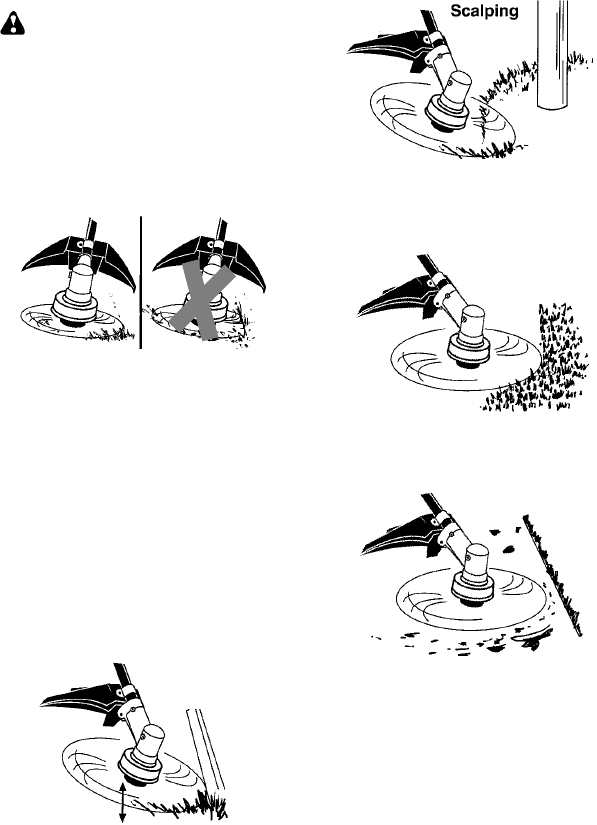
11
CUTTING METHODS
WARNING: Use minimum speedand
do not crowd the line when cutting around
hard objects (rock, gravel, fence posts, etc.),
whichcandamagethetrimmer head,become
entangled in the line, or be thrown causing a
serious hazard.
S The tip of the li ne does the cutting. You will
achieve the best performance and minimum
line wear by not crowding the line into the
cutting area. The right and wrong ways are
shown bel ow .
Right
Wrong
Tip o
f
line does
the cutting.
L
ine crowded into
work area.
S The line will e asily remove grass and weeds
from around walls, fences, trees and flower
beds, but it also can cut the tender bark of
trees or shrubs and scar fences.
S For trimming or scalping, use less than full
throttle toincreaseline lifeand decreasehead
wear, especially:
S During light duty cutting.
S Near objects around which the line can
wrap such as small posts, trees or fence
wire.
S For mowing or sweeping, use full throttle for a
good clean job.
TRIMMING -- Hold the bottom of the trimmer
head about 8 cm above the ground and at an
angle. Allow only the tip of the line to make
contact. Do not force trimmer line into work
area.
Trimming
8 cm above
ground
SCALPING -- The scalping technique re-
moves unwanted vegetation down to the
ground. Hold the bottom of t he trimmer h e ad
about8 cmabove t hegroundand atanangle.
Allow the tip of the line to strike the ground
around trees, posts, monuments, etc. This
technique increases line wear.
MOWING -- Your trimm er is ideal for mowing
in places conventional lawn mowers cannot
reach. In the mowing position, keep the line
parallel to the ground. Avoid pressing the
head into the ground as this can scalp the
ground and damage the tool.
Mowing
SWEEPING -- The fanning actionof therotat-
inglinecanbeusedtoblowaway loosedebris
from an area. Keep the line parallel to and
above the area surface and swing the tool
from side to side.
Sweeping
OPERATING INSTRUCTIONS FOR
USE WITH WEED BLADE
S Bla d e Thru s t is a reaction that only occurs
when using a bladed unit. This reaction can
cause serious i njury such as amputation.
Carefully study this section. Itis important t hat
you understand what causes bla de thrust,
how you can reduce the chance of its
occurring, and how you can remain in control
of unit if bl ade thrust occurs.
S WHAT CAUSES BLADE THRUS T -- Blade
Thrust can occur when the spinning blade
contacts an object that it does not cut. This
contact causes the b ladeto stopfor aninstant
and then suddenly m ove or “thrust” away
from the object that was hit. The “thrusting”
reaction can be violent enough to cause the
operator to be propelled in any direction and
lose control of the unit. The uncontrolled unit


















